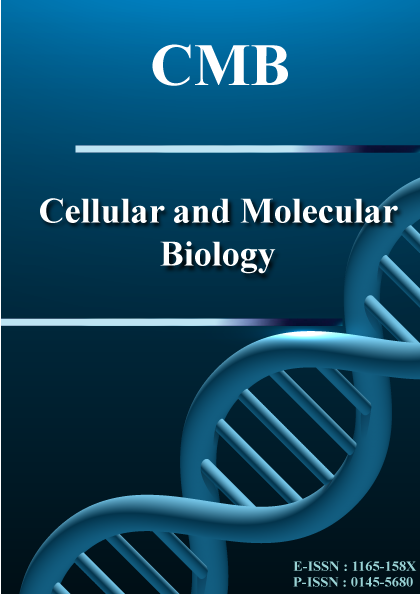Issue
Copyright (c) 2025 Lin Hong, Yaxing Fang, Tao Li; Yufeng He, Qin-Qin Jin, Xiao Xu; Shu-Guang Zhou

This work is licensed under a Creative Commons Attribution-NonCommercial-NoDerivatives 4.0 International License.
The undersigned hereby assign all rights, included but not limited to copyright, for this manuscript to CMB Association upon its submission for consideration to publication on Cellular and Molecular Biology. The rights assigned include, but are not limited to, the sole and exclusive rights to license, sell, subsequently assign, derive, distribute, display and reproduce this manuscript, in whole or in part, in any format, electronic or otherwise, including those in existence at the time this agreement was signed. The authors hereby warrant that they have not granted or assigned, and shall not grant or assign, the aforementioned rights to any other person, firm, organization, or other entity. All rights are automatically restored to authors if this manuscript is not accepted for publication.The disulfidptosis-related lncRNAs can predict survival and immunotherapy response accurately in endometrial carcinoma
Corresponding Author(s) : Shu-Guang Zhou
Cellular and Molecular Biology,
Vol. 71 No. 3: Issue 3
Abstract
Endometrial cancer of the uterine corpus (ECUC) is a common malignancy among females. Disulfidptosis, a recently identified form of cellular death, is characterized by elevated SLC7A11 expression and limited glucose availability, making it a potential cancer treatment target. In this research, clinical data and transcriptome information from EC samples were accessed from the TCGA database. A disulfidptosis-related lncRNAs(DRLs) prognostic signature was developed by univariate/LASSO/multivariate regression analyses. Cellular pathways were identified through GO, KEGG, and GSEA analyses. Immune infiltration as well as tumor mutational burden (TMB) were evaluated. The TIDE algorithm and the GDSC database were utilized to predict how patients reacted to immunotherapy as well as anticancer drugs. Finally, the expressions of disulfidptosis-related lncRNAs were measured using RT-qPCR. Results: In this study, we identified 524 disulfidptosis-related lncRNAs and developed a prognostic signature consisting of five DRLs (AC022960.1, PRDX6-AS1, EMSLR, AL359715.3, AC103563.9). Our prognostic signature effectively stratified EC patients into high- and low-risk groups. Compared with the high-risk group, patients in the low-risk group exhibited better overall survival (OS). Additionally, ROC curves and concordance index (C-index) plots were used to assess the accuracy of our prognostic signature. The results demonstrated that the AUC values for 1-, 3-, and 5-year survival were 0.676, 0.712, and 0.722, respectively, indicating high predictive accuracy. Further analysis revealed significant differences between high- and low-risk groups in terms of TMB, drug sensitivity, and immune cell infiltration. PCR results showed that PRDX6-AS1, EMSLR, AL359715.3, and AC103563.9 were upregulated in EC cells, whereas AC022960.1 was downregulated. In conclusion, we developed a DRLs signature capable of predicting the TMB, prognosis, and immunological cell infiltration patterns, as well as the reactions to immunotherapy in EC patients.
Keywords
Download Citation
Endnote/Zotero/Mendeley (RIS)BibTeX




